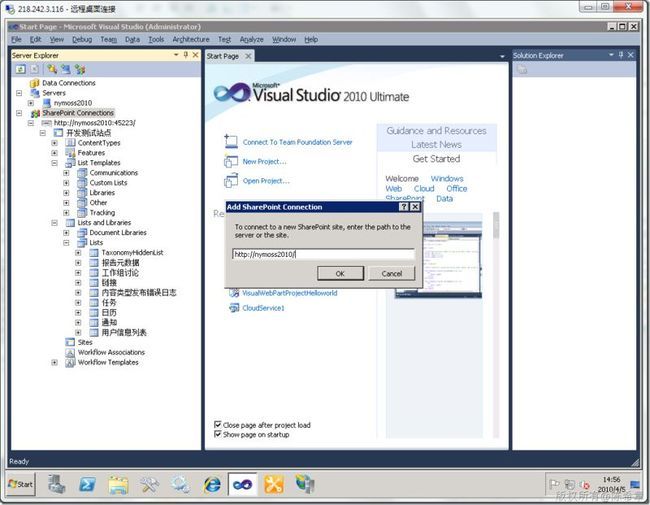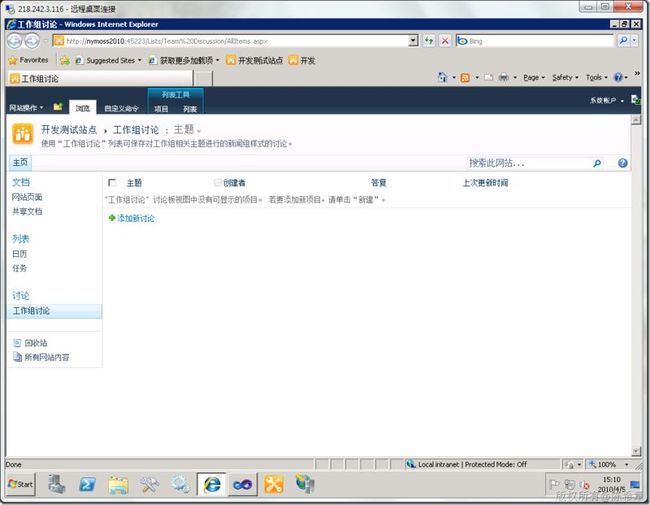MOSS 2010:Visual Studio 2010开发体验(1)——SharePoint Explorer
转载自:http://www.cnblogs.com/chenxizhang/archive/2010/04/05/1704680.html
你不得不感概,原先在MOSS 2007的时代我们是多么辛苦。不是吗?
- Visual Studio 开发体验受到局限
适用于 WSS 的 Visual Studio 扩展
Visual Studio Tools for Office 与 VS2008 之间的配合
SharePoint 开发人员需要依赖于社区工具 - 开发人员不得不应对层出不穷的细节工作
手工编辑 CAML 文件
熟悉 WSS 的 RootFiles 目录
手工编辑 manifest.xml 文件
为解决方案包构建 .wsp 文件
是的 ,对这些痛苦我们记忆犹新。好吧,现在是时候改变了
- SharePoint 2010 采用端到端的开发体验
用于浏览网站的 SharePoint Explorer
SharePoint 2010 项目与组件模板
适用于各种主要应用场景的可视化设计环境
为 Visual Studio 2008 for WSS 3.0 提供迁移路径
可由第三方开发人员进行扩展 - SharePoint 开发人员的好消息
实现 RootFiles 目录细节的简化
实现 .wsp 文件构建工作的简化
减少/避免对外部工具的使用需求
当然,前提是,你得拥有Visual Studio 2010,而且最好是装在服务器上面。听我的吧,这样可以避免很多问题,节省大量的时间。
这一讲介绍一下SharePoint Explorer
这个工具是集成在Server Explorer中的
很显然有了这个工具,就可以更好地理解一个SharePoint站点的结构了。目前这个工具,除了让开发人员更好地浏览SharePoint站点内容结构之外,如果我们在Lists上面去点击右键的话,还可以直接点位到该列表
我觉得这个工具还不是很完善,以后可能会更加强一些。例如直接可以拖拽到程序界面上这样的功能
关于 Explorer的扩展,如果有兴趣的朋友,可以参考下面的链接
http://msdn.microsoft.com/en-us/library/ee471438(VS.100).aspx
下面是有一个例子
using System.ComponentModel; using System.ComponentModel.Composition; using System.Windows.Forms; using Microsoft.VisualStudio.SharePoint; using Microsoft.VisualStudio.SharePoint.Explorer; using Microsoft.VisualStudio.SharePoint.Explorer.Extensions; namespace Contoso.ServerExplorerExtension { [Export(typeof(IExplorerNodeTypeExtension))] [ExplorerNodeType(ExplorerNodeTypes.SiteNode)] internal class SiteNodeExtensionWithContextMenu : IExplorerNodeTypeExtension { public void Initialize(IExplorerNodeType nodeType) { nodeType.NodeMenuItemsRequested += nodeType_NodeMenuItemsRequested; } void nodeType_NodeMenuItemsRequested(object sender, ExplorerNodeMenuItemsRequestedEventArgs e) { IMenuItem menuItem = e.MenuItems.Add("Display Message"); menuItem.Click += menuItem_Click; } void menuItem_Click(object sender, MenuItemEventArgs e) { IExplorerNode node = (IExplorerNode)e.Owner; MessageBox.Show(string.Format("Clicked the menu item for the '{0}' node.", node.Text)); } } [Export(typeof(IExplorerNodeTypeExtension))] [ExplorerNodeType(ExtensionNodeTypes.FieldNode)] internal class FieldNodeExtensionWithProperty : IExplorerNodeTypeExtension { public void Initialize(IExplorerNodeType nodeType) { nodeType.NodePropertiesRequested += nodeType_NodePropertiesRequested; } void nodeType_NodePropertiesRequested(object sender, ExplorerNodePropertiesRequestedEventArgs e) { // Only add the property to "Body" fields. if (e.Node.Text == "Body") { ExampleProperty propertyObject; // If the properties object already exists for this node, get it from the node's annotations. if (!e.Node.Annotations.TryGetValue(out propertyObject)) { // Otherwise, create a new properties object and add it to the annotations. propertyObject = new ExampleProperty(e.Node); e.Node.Annotations.Add(propertyObject); } e.PropertySources.Add(propertyObject); } } } internal class ExampleProperty { private IExplorerNode node; private const string propertyId = "Contoso.ExampleProperty"; private const string propertyDefaultValue = "This is an example property."; internal ExampleProperty(IExplorerNode node) { this.node = node; } // Gets or sets a simple string property. [DisplayName("ContosoExampleProperty")] [DescriptionAttribute("This is an example property for field nodes.")] [DefaultValue(propertyDefaultValue)] public string TestProperty { get { string propertyValue; // Get the current property value if it already exists; otherwise, return a default value. if (!node.Annotations.TryGetValue(propertyId, out propertyValue)) { propertyValue = propertyDefaultValue; } return propertyValue; } set { if (value != propertyDefaultValue) { // Store the property value in the Annotations property of the node. // Data in the Annotations property does not persist when Visual Studio exits. node.Annotations[propertyId] = value; } else { // Do not save the default value. node.Annotations.Remove(propertyId); } } } } }


